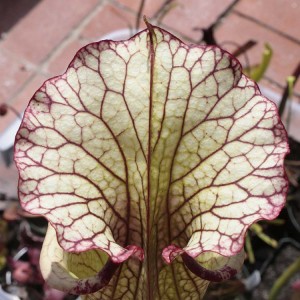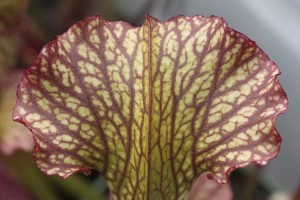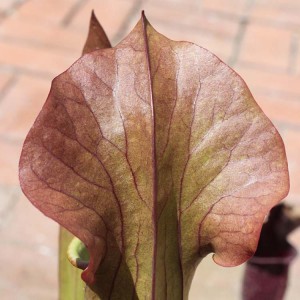
Today I feature some striking pitcher plant leaves to mark the occasion of April’s Foliage Follow-Up, the blog meme begun by Pam of Digging.
The story goes that the early settlers mistook the carnivorous trumpet-shaped leaves for flowers. And how could you blame them? These tall tubes formed from modified leaves feature interesting shapes and colors in the green-yellow-white-pink-red range, often with the colors forming striking patterns. They’re easily as interesting as most flowers.
Botanist Donald E. Schnell writes in Carnivorous Plants of the United States and Canada, “there seems to be nothing subtle about pitcher plants. Their general appearance begs attention, and when we encounter them we are almost startled. But once we look for awhile, then wander among them, we can begin to peel apart layers of subtlety and see many little secrets that collective fit these plants so neatly into their bog habitat–and we still do not know all their secrets.”
Schnell has divided the carnivorous pitcher leaf into 5 different zones, each with a different morphology. The scary insect-eating and -digesting carnivory takes place down in zones 3 and 4, the lower parts of the pitcher. But these photos concentrate on the backs of the top lid of these pitchers, the entire lid being what Schnell calls zone 1.









Even though my sarracenia plants get to live in a cushy USDA Zone 10 garden (not to be confused with the zones of a sarrecenia pitcher), their internal clocks seem more tuned in to seasonal cycles of daylength or relative temperatures than to absolute temperatures. Most of the species and hybrids have been suspicious of San Diego’s warm climate and keep their flowers and foliage developing in the rhizomes all winter. Only now are most beginning to bloom and send out leaves, though maybe a little bit earlier than in the American Southeast, where these plants originate.
As the season progresses, these leaves will often develop different colorations. The veins in some will grow more pronounced, some pitchers will go all-red, others will show a golden underglow. The brief burst of spring flowers in these plants is great, but the foliage makes for months of really cool leaf-viewing.
For all sorts of other foliage happenings in the garden world, check out the links in this month’s Foliage Follow-Up post at Digging. Thanks for hosting, Pam!
